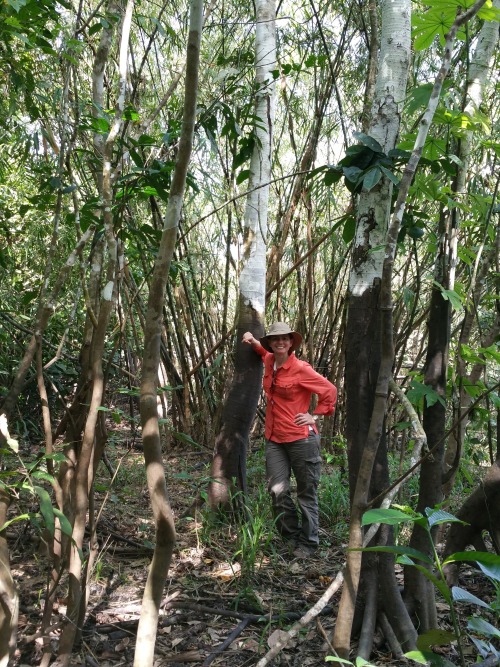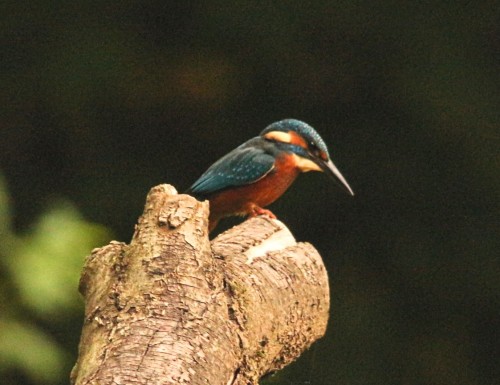Dive Deep into Creativity: Discover, Share, Inspire
Wetlands - Blog Posts

NASA Spotlight: Carbon Cycle and Ecosystems Earth Scientist Erika Podest
Dr. Erika Podest is a scientist with the Carbon Cycle and Ecosystems Group in our Jet Propulsion Laboratory’s Earth Science Division and Visiting Associate Researcher in the Joint Institute for Regional Earth System Science and Engineering (JIFRESSE) at UCLA. Her research entails using satellite images to study Earth’s ecosystems specifically related to wetlands and boreal forests and how they are being affected by climate change.
Erika took time from studying our home planet to answer questions about her life and career! Get to know our Earth Scientist:
What inspires/motivates you?
I am inspired by the beauty of nature, its perfection and by the peace it brings me. My motivation is to make a positive impact on our planet by better understanding it and caring for it.
What first sparked your interest in Earth science?
I was born and raised in Panama, which is a country with an exuberant nature. Since I can remember, I was always surrounded by nature because my father was an adventurer who loved the outdoors and always took me with him to go exploring or simply to enjoy a nice relaxing day outside. This led me to develop a deep sense of appreciation, respect, and curiosity for nature, which sparked my interest to learn about it and pursue a career in Earth Science.
What got you interested in the study of Earth from space?

Early in my college years I was training for my private pilot’s license and during my solo flights I would take pictures of features on the surface from the plane. I was always amazed at the details the pictures showed of the landscape that were not obvious from the ground. This was the first step towards discovering that there was a field for studying Earth from above, called remote sensing and consequently my Masters and Ph.D. were focused in this field.
What technology, discovery, or policy do you think has the most potential to decrease humans’ environmental impact (e.g. wind turbines, carbon taxes, clean meat)?
I don’t think it is a matter of any one technology, discovery or policy. It is a combination of everything. Having an impact on climate change involves every level and direction, from the bottom up at the individual, grassroots and community level to the top down at the policy level. As individuals, I think it is important to educate ourselves about climate change (I suggest climate.nasa.gov). We all have the power to make a positive change by speaking up and making informed decisions about our consumptive habits.
What’s a fact about the role of wetlands and boreal forests in the global ecosystem that you think would surprise people?

Wetlands provide a vital role in carbon storage. Even though they cover about 5-8% of the Earth’s land surface, studies indicate that they contain a disproportionate amount of our planet’s total soil carbon, about 20-30%. In addition, they are like the arteries and veins of the landscape, acting as water sources and purifiers and helping in flood control. They also protect our shores and harbor large amounts of biodiversity.
Boreal forests are found in the uppermost northern hemisphere (Alaska, most of Canada, Russia, Scandinavia and northern Asia) and account for about 30% of the world’s forest cover. These forests lock up enormous amounts of carbon and help slow the increasing buildup of carbon dioxide in our atmosphere. In their peak growth phase during the northern spring and summer, the worldwide levels of carbon dioxide fall and the worldwide levels of oxygen rise.
Can you describe a typical day on a research trip?

It depends on the research trip. For example, one of my more recent ones was to the Peruvian Amazon where we went upriver on a boat for three weeks on a major tributary of the Amazon River called the Ucuyali River. I was with a team of eight researchers and we were studying the wetland ecosystems of the Pacaya-Samiria Natural Reserve, which entailed making vegetation measurements and assessing inundation extent to validate our scientific findings from satellite observations. We camped for most of the trip and a typical day entailed waking up at around 5:00 am with a symphony of sounds that emerged from the forest, including monkeys. We had breakfast and set off from base camp into the forest (~1 hour walk) to work an 8-9 hour day with a short lunch break (we had packed lunches) at noon. At the end of the day I’d be drenched in sweat, sunscreen, insect repellent, and dust and I’d bathe with water from the river, which was as brown as a milk chocolate bar. It was the most refreshing and cleansing feeling! The day would close with dinner followed with a discussion of the measurements to be collected the following day. Lights were out by 7:30 pm (which seemed like midnight) and I’d re-emerge myself into my tent in the dark tropical night surrounded by the sounds of the forest, until the next morning.
What are some of the most important lessons you’ve learned in life?
That it is important to be patient, humble and thankful.
Do you have any secret skills, talents, or hobbies?
Great question! I do not have any secrete skills or talents but I do have a couple of hobbies. I play the piano, though I am still a novice. I love windsurfing. It is an amazing feeling to skim over the water at fast speeds (I’m also an adrenaline junkie). Finally, I am fascinated by magic card tricks and whenever I have some free time I like to learn a new trick.
What do you enjoy the most about your job?
I enjoy constantly learning about our natural world and how it works. I also really enjoy communicating my work to students and to the general public. I find it especially rewarding when I can educate people and motivate students to consider careers in science.
Erika, thank you for your time and everything you do to keep our home planet safe!
Make sure to follow us on Tumblr for your regular dose of space: http://nasa.tumblr.com.

For the Love of Peat: Our Best Defence Against a Changing Climate
Canada holds between a quarter and a third of the world’s peatlands. It’s time we took better care of them
Canada holds between a quarter and a third of the world’s peatlands, including acidic bogs and more alkaline fens as well as swamps and marshes. They can be found across the country, from British Columbia to the Northwest Territories to Nova Scotia, growing many metres deep into the ground. Due to their density of decomposed or decomposing plant material, one square metre of peatland in northern Canada holds approximately five times the amount of carbon as one square metre of tropical rainforest in the Amazon. But the country’s peatlands have been so degraded by the construction of mines and hydroelectric dams, by oil-and-gas developments, and by urban expansion that we are losing an ecosystem crucial to the prevention of natural disasters such as forest fires—as well as destroying a key mitigator of climate change.
Read more at thewalrus.ca.
Illustration by Kyle Scott (kjscott.com).
This is a good point. I think it can also be applied to marine environments (it's not just the coral reefs that need saving)
something i've noticed. people seem to think the most nature-y nature is forests. so forests are always prioritized for conservation, and planting trees is synonymous with ecological activism. my state was largely prairies and wetlands before colonization. those ecosystems are important too. trees aren't the end-all be-all of environmentalism. plant native grasses. protect your wetlands.





A few photos from upton warren Worcestershire

Autumn leaves.

Backyard Natural Stone Pavers (New York)

Everglades (and south Florida, including Miami) with 5ft of sea level rise

Everglades (and south Florida, including Miami) with 4ft of sea level rise

Everglades (and south Florida, including Miami) with 2ft of sea level rise

The Florida Everglades, where elevation above sea level is often measured in single digits, is on of the most susceptible areas of the country to sea level rise. In addition to its low coastal elevation, the Everglades are threatened as a result of a history of wetland degradation that changed the way water flowed through the large wetland system. Restoring natural freshwater flows will help protect the everglades from the intrusion of salt water due to sea level rise, but it must be done quickly.
Dr. Harold Wanless of the University of Miami Department of Geological Sciences created a series of maps showing the Everglades under varying scenarios of sea level rise. This is the Everglades in 1995.

While deforestation is a major source of global carbon emissions (see previous two posts), the expansion of agriculture into drained organic soils also releases carbon. Wetlands, and especially peatlands, have waterlogged soils. As a result, their soils are depleted of oxygen, preventing decomposition. This means that the carbon in plants and animals is stored in the soils. When these soils are drained, the oxygen returns and organic material decomposes. Decompostion releases the carbon stored in that material. Thus, draining wetland soils releases carbon dioxide and contributes to climate change.
FAO adds emissions from cropland expansion into drained organic soils to deforestation. The result: significant increases in carbon emissions from Indonesia, which has substantial peatlands.

Predicted land change along the Louisiana coast over the next 50 years if we do nothing more than we have done to date. Red indicates areas likely to be lost, and green indicates areas of new land. This map is based on assumptions about increases in sea level rise, subsidence, and other factors.
The global rise in mean sea level is complicated in the Mississippi River Delta region by subsidence (sinking land). The Gulf of Mexico has one of the highest rates of subsidence in the nation due to sediment compaction and the extraction of groundwater, oil and natural gas. Restoration of the deltaic system can help stabilize shorelines and reduce the associated risks with rising sea levels. Deltas are formed by the constant inflow of sediment from rivers. However, the Mississippi River Delta has been cut off from this natural process through the construction of extensive levee systems for navigation and flood protection. Through planned sediment diversions, the natural deltaic process can be restored and help increase the resiliency of coastal areas.

Wetlands losses and gains for different land use categories. While, historically, agriculture was responsible for the vast majority of wetlands losses, government incentive programs like the Wetlands Reserve Program have encouraged farmers to restore former wetlands on their lands, contributing to a net gain of wetlands from the agriculture sector 2004-2009. In contrast, silviculture (forestry) is contributing heavily to wetlands losses, with urban and rural development also destroying wetlands. Urban and rural development combined accounted for 23 percent of the wetland losses 2004-2009, while silviculture accounted for 56% (a decrease from 1998-2004 for urban and rural development and an increase for silviculture).
*"Other" included areas such as native prairie, un-managed forests, scrub lands, barren and abandoned land, lands enrolled in conservation easements or other lands designated as wildlife management areas. Conservation programs are largely responsible for high wetlands gains from these areas.

Average annual net loss and gain of wetlands in the lower 48 states of the U.S. Wetlands protection regulations (such as those under the Clean Water Act 404), incentive programs (such as the Wetlands Reserve Program) and disincentive programs (such as the Swampbuster provision of the Food Security Act of 1985) have substantially reduced wetlands losses.













